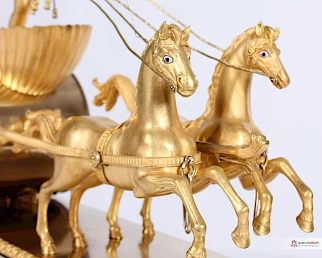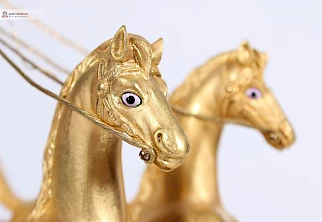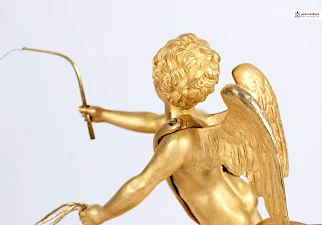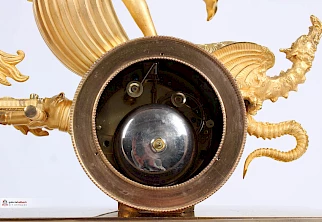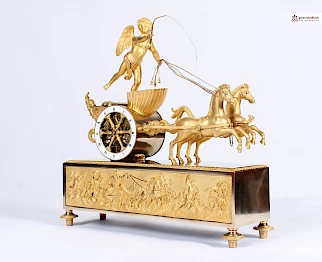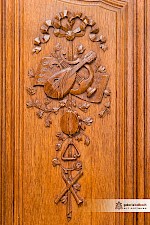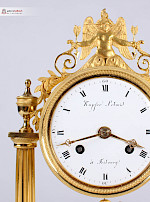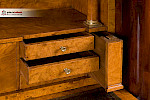Char de l'Amour - Cupid's Chariot
France
fire-gilt bronze
Empire around 1810
Dimensions: H x W x D: 47 x 48 x 15 cm
Description:
Depiction of winged Cupid mounted on rectangular plinth box, triumphantly steering the two-horse Biga.
Cupid stands light-footed on one leg, holding the reins in one hand and the whip in the other. The chariot is pulled by two dynamically moving horses.
The wheel of the carriage, worked out as a half-skeleton clock face, shows the time.
On the base relief we see Apollo driving through the sky in his four-horse carriage. His entourage includes Mercury the messenger of the gods and a writing muse. Also part of the triumphal procession are two putti, one carrying a fruit basket, the other a laurel wreath.
Eight-day movement with strikes on the half and full hour.
Thread suspension of the pendulum.
Enamelled eyes of the horses.
Points of interest:
At the time of the Empire (early 19th century) it was not possible to cast complex bronzes in one piece. The art therefore consisted, among other things, of joining the individual parts together "invisibly".
The Cupid of this clock, for example, consists of a total of six individually cast parts. The body was cast in two separate halves, the two wings also individually. The breast band, the toga, also consists of two individual parts.
Assembled together, the joint of the two halves of the body is concealed by the chest band. The parts are screwed together, you can see one of the screws in the photo showing the boy's shoulder.
The wings are soldered to the body.
The same applies to the horses and the chariot.
The plastic elements were all cast using the lost wax process. This means that a previously made mould was filled with liquid bronze. After hardening, the mould was broken; this is why we speak of the so-called "lost mould".
It is different with the bas-relief of the base. Less complicated forms, such as these, could be cast in negative moulds that could be used several times.
After casting, the bronzes were reworked, chased and then fire-gilded.
With the background knowledge of how bronzes were created at the time of the Empire, one looks at the beauty of these objects with completely different eyes.
For those interested in the subject, I recommend the book Die französische Bronzeuhr by Elke Niehüser.
Condition:
Restored condition. Movement and case completely cleaned. The clock runs perfectly reliable.
Models of this very famous clock are illustrated among others:
Elke Niehüser - The French Bronze Clock p. 103
Patrimonio Nacional Madrid - Catalogo de Relojes p. 123
Article found under: Clocks
Also interesting
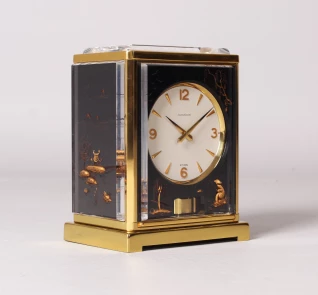
Jaeger LeCoultre - Atmos "Chinois
Switzerland
Brass, plexiglass
Year of manufacture 1965
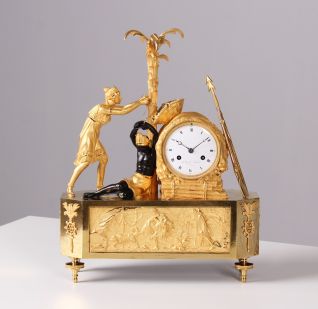
Mantel Clock "Atala and Chactas"
Paris
Bronze (fire-gilt and patinated), enamel
Empire around 1810
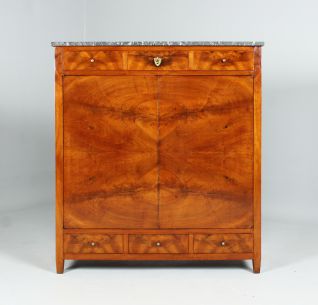
Semaniere with interesting locking technology
Belgium
Walnut, oak
early 19th century

